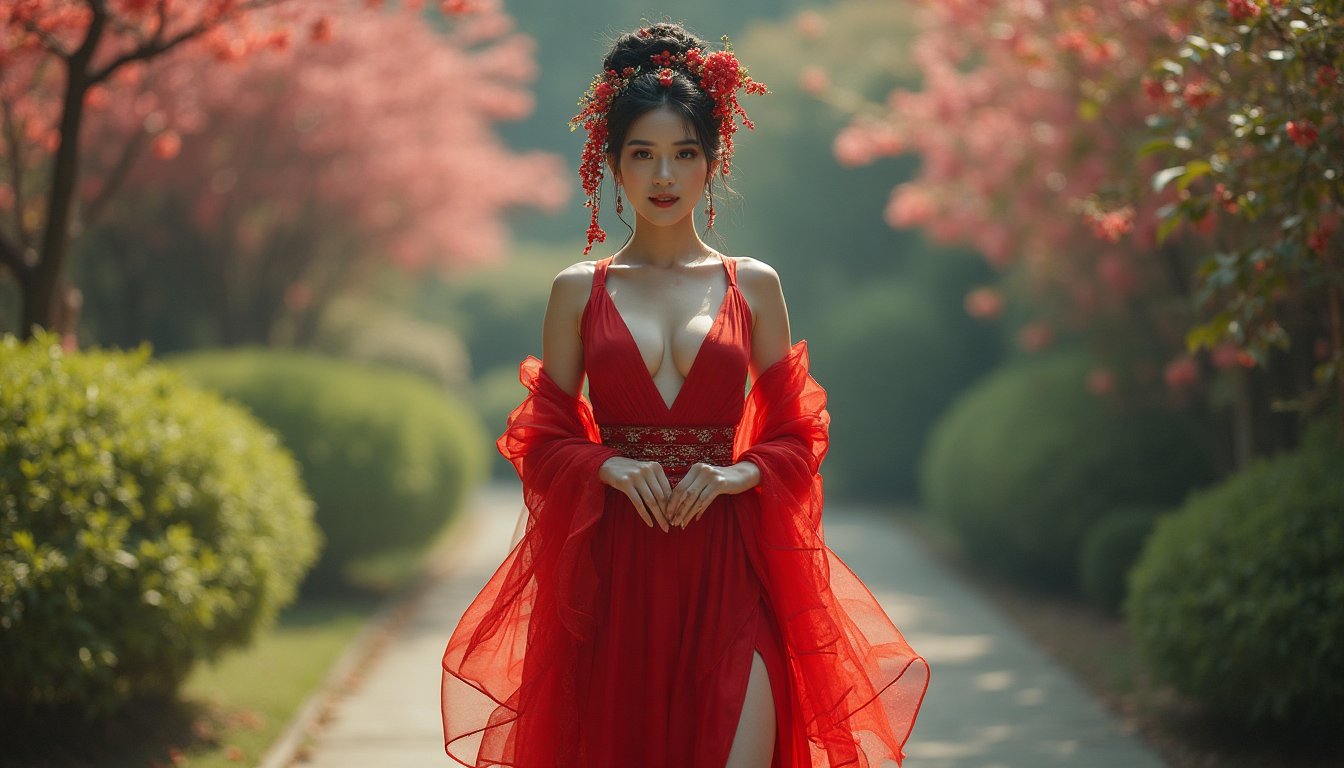Love Across Time: Navigating the Complexities of a Relationship Between Cultures
What if love could transcend time and culture, blending the rich heritage of one era with the liveliness of another? Imagine a relationship that combines Japanese traditions from the Edo period with modern influences, creating a tapestry of experiences that resonates deeply in today’s world. This exploration into the dynamics of such a relationship invites you to dive into both the beauty of connection and the challenges couples might face.
In a vibrant scene like Shinjuku Gyoen National Garden, imagine a stunning Japanese woman, dressed in alluring crimson attire, reflecting a mix of historical elegance and contemporary flair. Her attire, with daring cuts and bold colors, symbolizes the blending of two worlds. She stands firm in her identity yet open to the infusions of modernity, much like relationships between individuals from different backgrounds can thrive by embracing both their histories and present.
The Allure of Cultural Interaction
When two lives intersect, particularly from diverse cultural backgrounds, it’s like creating a stunning artwork that bridges tradition and innovation. Each partner brings unique stories, traditions, and love languages to the table. For instance, take a couple where one partner celebrates the Japanese customs of respectful communication and indirect expression, while the other embodies the more direct style of communication common in many Western cultures. This mix can create both a beautiful dance and a potential misstep.
Example: Imagine a scenario where the Japanese partner feels the need for subtlety when expressing affection, perhaps sending a heartfelt text while the other partner expects a verbal declaration of love. Such misunderstandings, if left unaddressed, can create a gap that might make either person feel undervalued or unheard.
Celebrating Differences
On the brighter side, the rich histories each partner carries can be a source of celebration and connection. Couples who thrive in multicultural relationships often find that exploring each other's traditions can deepen their bond. Picture a vibrant celebration of Hanami—the Japanese tradition of enjoying cherry blossoms—where the couple invites friends from various backgrounds to partake in a picnic under the blooming trees.
During these events, they discover new food flavors and cultural practices, sharing laughter and love. Experiences like this highlight the beauty of their union, allowing both partners to showcase their heritage while creating a shared narrative.
Fun fact: Studies from the Pew Research Center show that multicultural couples tend to have a broader social network and more resilience in navigating challenges compared to their monocultural counterparts. They experience heightened levels of understanding due to their exposure to diverse worldviews.
Navigating Challenges: The Power of Love Languages
The interplay of different love languages can be fascinating yet challenging. Perhaps the Japanese partner expresses love through acts of service—preparing a meal or doing chores, while the Western partner values quality time, wanting shared experiences and conversations. These differing languages can create misunderstanding unless both partners make an effort to bridge the gap.
To navigate these waters effectively, it would be beneficial to identify and celebrate each other's love languages. A simple yet profound activity could entail setting aside time for a weekly “love language date.” Picture this: one week, they might decide to perform acts of service for each other, and the next, they might dedicate time entirely to exploring each other's interests.
Tips to Bridge Love Languages:
- Communicate Openly: Discuss what makes each partner feel loved and appreciated.
- Experiment Wisely: Try expressing love in ways that are outside your comfort zone.
- Show Patience: Understand that learning each other's languages takes time.
The Role of Community and Family Expectations
Living in a multicultural relationship also means navigating familial and societal expectations. Traditional views can sometimes pose challenges. Consider a situation where the Japanese partner's family might have strong expectations regarding marriage customs, while the Western partner’s family might emphasize personal choice and independence.
Example: Imagine family gatherings filled with questions about when to plan a wedding or how to merge traditions. Balancing these can be tricky. Couples should approach such discussions with respect and a shared vision, which fosters understanding without alienating either side.
One strategy could be holding joint family meetings where both sets of families express their hopes and concerns. This approach not only fosters understanding but also creates a foundation of support from both sides.
The Beauty of Shared Growth
Through challenges and celebrations, partners in multicultural relationships often find that they grow both individually and as a couple. They gain insights into different worldviews, paving the way for increased empathy and understanding.
Consider a couple taking a cooking class together, blending traditional Japanese cuisine with a Western twist. By learning to create dishes from each other's cultures, they not only forge culinary skills but also broaden each other's horizons, adding new dimensions to their relationship.
Fun fact: Research published in the Journal of Marriage and Family indicates that couples who engage in shared activities report higher levels of satisfaction in their relationships. Sharing joys, struggles, and creative endeavors can lead to a deeper connection.
Conclusion: Celebrating the Journey
In our journey through the dynamics of relationships, it becomes clear that love, much like the stunning scene of a woman adorned in a breathtaking outfit in a magnificent garden, is multifaceted and adaptive. Cultural differences, while potentially challenging, add vibrant colors to the canvas of companionship. Through open communication, shared experiences, and the celebration of each other’s backgrounds, couples can not only survive but truly thrive together.
So, if you find yourself standing at the crossroads of cultures, embrace the rich history and the beautiful present that each partner brings. Remember that love is a journey, not a destination—one adorned with cherry blossoms, laughter, and shared passion.
What challenges have you faced in your relationship? How have they shaped your love story? Share your thoughts in the comments below!
Don't forget to subscribe to our newsletter and become a permanent resident of iNthacity: the Shining City on the Web. Join the conversation, like, share, and let’s keep the dialogue going!
Disclaimer: This article may contain affiliate links. If you click on these links and make a purchase, we may receive a commission at no additional cost to you. Our recommendations and reviews are always independent and objective, aiming to provide you with the best information and resources.
Get Exclusive Stories, Photos, Art & Offers - Subscribe Today!
























Post Comment
You must be logged in to post a comment.